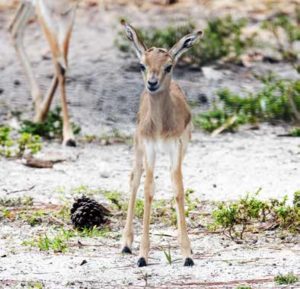Meet Naples Zoo’s Adorable New Additions
 If you’ve visited Naples Zoo lately, you may have noticed two new adorable faces in the bongo and gazelle yards. A male Eastern bongo calf was born December 30, 2019 to parents Amara and Sebastian, and a male slender-horned gazelle was born January 22 , 2020 to parents Clyde and Clover.
If you’ve visited Naples Zoo lately, you may have noticed two new adorable faces in the bongo and gazelle yards. A male Eastern bongo calf was born December 30, 2019 to parents Amara and Sebastian, and a male slender-horned gazelle was born January 22 , 2020 to parents Clyde and Clover.
The gazelle calf is named Colby-Jack, a special name for a few reasons. First, since his parents are named Clyde and Clover, his keepers wanted a “C” name. Second, it was “National Cheese Lovers Day” a couple days before his birth. And third, our President and CEO Jack Mulvena was the first person to see the baby after he was born!
The bongo calf was named Makumi by his keepers, which means tens in Swahili. He was the 10th mammal born at Naples Zoo in 2019 and was born at the end of the 2010s. Eastern bongos are the largest of the forest antelope. Slender-horned gazelles have a small, compact build. For size comparison, the gazelle calf weighed just 3.5 pounds at birth, while the bongo weighed approximately 48 pounds!
These births are very important for the conservation of their species, as both the Eastern bongo and slender-horned gazelle are
critically endangered. Eastern, or mountain, bongo were hunted out over a century ago in Uganda and only about 100 of these
beautiful antelope remain in the wild in Kenya. Slender-horned gazelles are also affected by hunting and increased human activity in their ranges.
 Naples Zoo works to save these species by participating in the Association of Zoos and Aquariums (AZA) Species Survival Plan® (SSP). This national plan helps to create sustainable populations of threatened and endangered species. The parents of each of the babies were specifically matched by the SSP based on their ancestry, to create the greatest genetic diversity in the population over the next century. When explaining the SSP to guests, keepers say it’s like a scientific version of both Match.com and Ancestry.com.
Naples Zoo works to save these species by participating in the Association of Zoos and Aquariums (AZA) Species Survival Plan® (SSP). This national plan helps to create sustainable populations of threatened and endangered species. The parents of each of the babies were specifically matched by the SSP based on their ancestry, to create the greatest genetic diversity in the population over the next century. When explaining the SSP to guests, keepers say it’s like a scientific version of both Match.com and Ancestry.com.
If you haven’t made it to see the babies yet, their yards are located across from the tortoise exhibits and between the clouded leopard and cotton-top tamarin exhibits. You can’t help but fall in love when you look at their sweet faces



Leave a Reply
Want to join the discussion?Feel free to contribute!